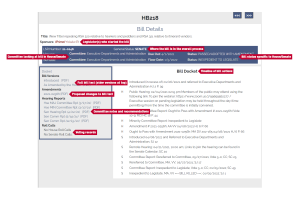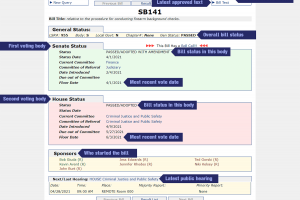Keys to the New Hampshire Legislature website
When you search for a bill on the New Hampshire Legislature website, gencourt.state.nh.us, you will find a detailed bill page.
Click the image below to see a key to the information on an official bill page:

The Legislature redesigned their website in 2022. Bills from 2021 and earlier may link to a different style of page. Click the image below to see a key to the information on these older bill pages:

The following is a glossary of the most common terms that appear on a bill status page. If you ever see a term not included on this list, feel free to e-mail us at info@citizenscount.org and ask for a definition.
AA
This abbreviation may be seen in a bill docket, the timeline of actions on a bill. It stands for “amendment adopted,” meaning legislators voted to adopt the amendment (change) listed on that line.
Concurred
If the Senate makes some changes to a bill that already passed the House, the House must vote to “concur” with those changes. The opposite is also true – if the House makes some changes to a bill that already passed the Senate, the Senate must vote to “concur” with those changes. This status means the body agreed with any changes.
Conference Committee
If the House and Senate both want to pass a bill but can’t agree on the final version, a conference committee is formed to draft a compromise bill. Conference committees include both House and Senate members. This status means a bill is being worked on in a conference committee.
Conference Report Adopted
This status means the compromise bill drafted by a conference committee passed.
DV
This abbreviation may be seen in a bill docket, the timeline of actions on a bill. It stands for “division vote,” meaning legislators each had their vote recorded individually but without sharing their name.
Executive Session
This refers to a committee meeting when the members vote on their final bill recommendation. A committee may recommend the full House or Senate kill a bill, study a bill, amend a bill, or pass a bill.
In Committee
This status means a bill is being considered by a committee. That committee provides the full House or Senate with a recommendation on the bill, but the full House and Senate don’t have to follow committee recommendations when it comes time to vote.
Indefinitely Postponed
This status means the House or Senate voted to kill the bill. This also means that the legislators cannot take up this bill's topic for the rest of the two-year term.
Inexpedient to Legislate
This status means the House or Senate voted to kill the bill.
Interim Study
This status means the bill will be studied between legislative sessions. This can be a polite way to kill a bill, especially in an election year.
Laid on Table
This status means the House or Senate voted to set aside the bill. They can vote at a later date to take the bill off the table and continue the legislative process. If they do not vote to take the bill of the table by the end of the legislative session, the bill dies.
MA
This abbreviation may be seen in a bill docket, the timeline of actions on a bill. It stands for “motion adopted,” meaning legislators voted to agree with the action listed on that line.
Miscellaneous
This is a catch-all for unusual bill statuses. During the COVID-19 pandemic, this status was applied to many bills that the House ran out of time to vote on. Those bills are dead due to inactivity.
Nonconcurred Request Conference
If the Senate makes some changes to a bill that already passed the House, the House must vote to “concur” with those changes. The opposite is also true – if the House makes some changes to a bill that already passed the Senate, the Senate must vote to “concur” with those changes. “Nonconcurred Request Conference” means that the House or Senate didn’t agree with the changes to a bill, and requested a conference committee to reach a compromise.
Passed/Adopted
This status means the bill passed without any new changes.
Passed/Adopted with Amendment
This status means the bill passed, but with an amendment or change to the original bill.
RC
This abbreviation may be seen in a bill docket, the timeline of actions on a bill. It stands for “roll call,” meaning legislators voted one by one and had their votes recorded.
Report Filed
This status means the committee working on a bill reported a recommendation to the full House or Senate. A vote by the full House or Senate comes next.
Rereferred
This status means the full Senate sent the bill back to committee for further consideration.
Retained in Committee
This status means the House committee working on the bill decided to hold onto the bill for now. This gives the committee more time to work on the bill. However, sometimes committees retain legislation as a polite way to kill a bill or make way for an alternate proposal.
Signed by Governor
This status means the governor signed the bill into law.
Vetoed by Governor
This status means the governor rejected or "vetoed" the bill.
Veto Overridden
This status means two-thirds of the Legislature voted to override or overturn the governor's veto. The bill becomes law.
Veto Sustained
This status means less than two-thirds of the Legislature voted to override or overturn the governor's veto. The governor's veto stands.
VV
This abbreviation may be seen in a bill docket, the timeline of actions on a bill. It stands for “voice vote,” meaning legislators voted out loud, saying “yea” or “nay” in chorus. In this case, the louder side wins!










